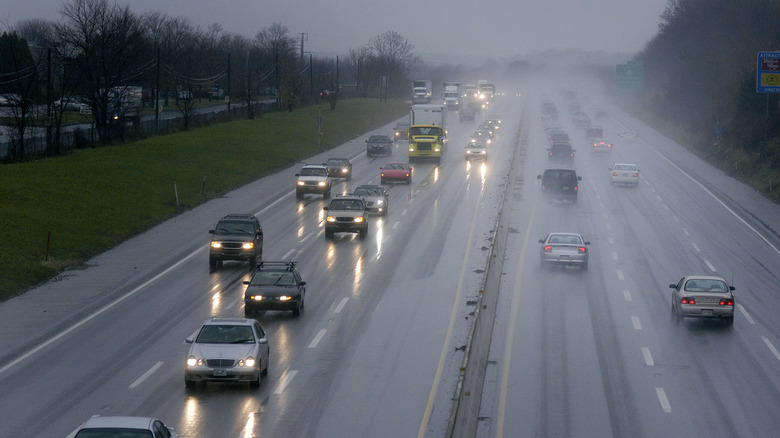One Of America's Most Hated Roads Is A Pennsylvania Highway To Avoid On A Road Trip
The Pennsylvania Turnpike is not anyone's version of paradise. It's an East Coast highway, so the Turnpike is crushingly boring by default — two or three lanes of asphalt extending forever, with miles of trees and grass on either side. But if you're driving from, say, Newark, New Jersey to Columbus, Ohio, you'll be amazed how much of this route takes place on a single road: The Turnpike extends 550 miles from end to end. In short, Pennsylvania is probably much bigger than you think it is, and most of what you pass is a succession of meaningless exit signs. The middle of the state is consistently rural, peppered with obscure towns, for more than half the width of the Eastern Standard time zone.
Sure, lots of interstates are long and dull to look at, and this segment of I-76 isn't the longest or dullest out there. Sure, Pennsylvania can't help its endless queue of storms, which dump as much as 50 inches of rain per year and lead to 120 to 162 overcast days, making journeys feel clammy and gray. And yes, construction is a fact of life, so the Turnpike needs dozens of work zones and realignments at any given moment to stay safe and efficient.
Yet drivers must also pay for all this: A trip from the New Jersey border to the Ohio border will cost you about $79; if you use E-Z Pass, you'll pay $39.54. It's already the most expensive toll road in the U.S., and in 2025, officials raised prices for the 17th consecutive year by 5%. And not one of Pennsylvania's most adventurous road trips takes place on this route. Take all these qualities together, and you have one of the most hated roads in America — and one to avoid, if possible.
Growing resentment on the Pennsylvania Turnpike
When the Turnpike first opened on Oct. 1, 1940, "America's First Superhighway" signaled a major change in U.S. transportation. The highway was 160 miles long, which was barely imaginable at the time. For decades, east-west drivers simply accepted the Turnpike as the fastest route available, especially between Philadelphia and Pittsburgh, even as the road was expanded and attracted more traffic. This was an East Coaster's gateway to the Midwest and vice versa.
But no one has ever liked paying tolls, and the Turnpike has struck many drivers as a racket. Part of the frustration is that the tolling system is hard to comprehend when you drive up that entrance ramp. In theory, taking a Class 1 vehicle on any part of the Turnpike will cost you seven cents per mile plus $1.09 per segment, though most drivers won't know exactly how far they're going or what the heck "a segment" is.
Then there's the traffic: The Turnpike of 1940 saw 6,575 vehicles per day; in the 2020s, the Turnpike sees 572,920, or about 87 times more traffic volume. This highway is a major shipping route as well, so drivers will have to play hopscotch with 96,684 commercial vehicles every 24 hours; at certain times of night, a line of trucks may extend as far as the eye can see, which is all the more stressful in heavy rain or snowstorms. I-76 isn't the most dangerous U.S. highway, but all this congestion results in a good number of incidents, which you can watch in real-time on the 511 website.
How to embrace the Pennsylvania Turnpike, or just skip it
The Turnpike isn't all bad: If you can stomach the expense and long distances, you may enjoy the rolling hills of Central Pennsylvania, as well as four long tunnels, which break up the monotony. The route also maintains 17 service plazas, averaging 32 miles between one and the next. If you're not in a hurry, the Turnpike passes through many bucolic towns and roadside attractions, like Frank Lloyd Wright's Polymath Park and Coral Caverns, although these sometimes require you to exit in odd locations and take secondary roads for a good way. Even if you hate it, the Turnpike should only take about six or seven hours of your life, depending on traffic and the number of breaks you take.
But in the age of GPS, many travelers have found that skipping the Turnpike is as easy as toggling the "avoid tolls" switch on Google Maps. If you're heading across the state as fast as possible, the Turnpike may be a necessary pain. However, as columnist Sean Collier asserted in a Pittsburgh Magazine article, there are alternate routes to major destinations like Lancaster and Washington, D.C., that only add 20 to 40 minutes — and cost nothing. "You pass way more fudge shops, old-school diners, and tourist traps if you don't take the turnpike," Collier adds.
Back in the 1940s, this road was state-of-the-art, paving the way for the Age of the Automobile. Today, it's just another interstate, with more than its share of cloudy skies, traffic cones, and unremarkable rest stops. There are lots of must-see cities in Pennsylvania and lots of ways to get there. Taking the Turnpike, however, will take its toll.


